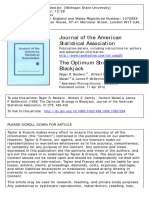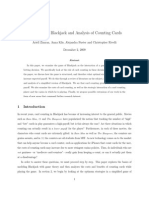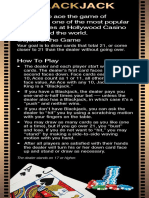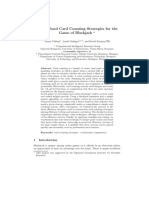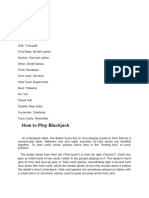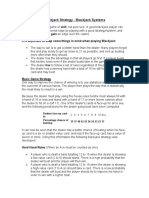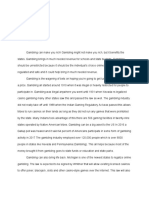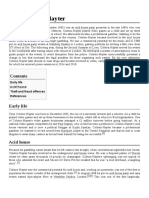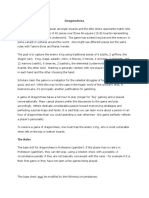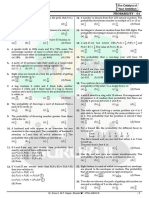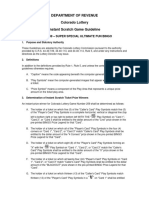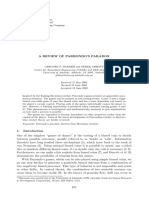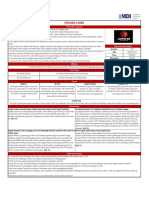The Optimun Strategy
Uploaded by
Jose HernandezThe Optimun Strategy
Uploaded by
Jose HernandezThe Optimum Strategy in Blackjack
Author(s): Roger R. Baldwin, Wilbert E. Cantey, Herbert Maisel and James P. McDermott
Source: Journal of the American Statistical Association, Vol. 51, No. 275 (Sep., 1956), pp. 429-
439
Published by: American Statistical Association
Stable URL: http://www.jstor.org/stable/2281431 .
Accessed: 11/06/2014 10:58
Your use of the JSTOR archive indicates your acceptance of the Terms & Conditions of Use, available at .
http://www.jstor.org/page/info/about/policies/terms.jsp
.
JSTOR is a not-for-profit service that helps scholars, researchers, and students discover, use, and build upon a wide range of
content in a trusted digital archive. We use information technology and tools to increase productivity and facilitate new forms
of scholarship. For more information about JSTOR, please contact support@jstor.org.
American Statistical Association is collaborating with JSTOR to digitize, preserve and extend access to Journal
of the American Statistical Association.
http://www.jstor.org
This content downloaded from 62.122.73.195 on Wed, 11 Jun 2014 10:58:09 AM
All use subject to JSTOR Terms and Conditions
JOURNAL OF THE AMERICAN
STATISTICAL ASSOCIATION
Number275 SEPTEMBER 1956 Volume51
THE OPTIMUM STRATEGY IN BLACKJACK
ROGER R. BALDWIN, WILBERT E. CANTEY, HERBERT MAISEL, JAMES P. MCDERMOTT*
AberdeenProvingGround,Maryland
This article discusses the card game blackjack as played in the
casinos of Las Vegas. The basic rules for the game are describedin
detail. The player'sstrategicproblemsare analyzed withthe objective
of findingthe strategymaximizinghis mathematicalexpectation.
A mathematicalexpressionis derivedgivinga generalsolutionto the
player's problemof standingpat with a given hand versus drawing
additionalcards. No generalsolutionsare possibleforthe othermajor
strategicproblems,however,and a detailedexaminationof individual
situationsis required.The formulasand methodsforthe case analysis
are stated,but computationaldetailsare omitted.Similarly,theformula
forthe player's mathematicalexpectationis stated,but its numerical
evaluationis not described.Detailed discussionis givento theproblems
arisingin the combinatorialtype of computationsrequiredby black-
j ack.
The "optimumstrategy"determinedby the above analysis differs
substantiallyfromthe published strategiesof card experts and the
usual styleof play in the casinos.
B
I. THE GAME OF BLACKJACK
LACKJACK or twenty-one is oneofthemostwidelyplayedgamesin Ameri-
can homes and clubs and traditionallyrivals poker forpopularityin the
Armed Forces. In Las Vegas, Reno, and other parts of the wide-openspaces
blackjack ranks with poker, roulette,and craps as one of the four standard
gamblinggames. Of thesefour,however,blackjack is by farthe most neglected
in the scientificliteratureof gamblingand offersa relativelyunexploredarea
formathematicaland statisticalanalysis.
It should be made clear at the outset that this paper deals exclusivelywith
the "house" game of blackjack and not the "private" game. In the house game
a representativeof the gamblingcasino is permanentdealer, and his strategy
is completelyfixedby knownhouse rules. The fixedand knownnature of the
dealer's strategy is vital in reducing the mathematical and computational
problemsin analyzing blackjack to manageable proportions.
Each gamblingcasino has a set of blackjack rules whichagree with those of
other casinos on the main points but which usually differon details. There-
fore,in selectinga variationof the game of blackjack foranalysis,the best that
could be done was to considerrules which are common but not universal.A
presentationof these rules follows.
* The authorswere ably assisted by Otto Dysktra,General Foods Laboratories,Hoboken, N. J.
429
This content downloaded from 62.122.73.195 on Wed, 11 Jun 2014 10:58:09 AM
All use subject to JSTOR Terms and Conditions
430 AMERICAN STATISTICAL ASSOCIATION JOURNAL, SEPTEMBER 1956
1. The Numberof Players. A dealer and fromone to six players.
2. The Pack. An ordinary52-carddeck.
3. Betting.The players make their bets beforeany cards are dealt. The
house establishesa minimumand a maximumbet.
4. The Deal. The players and dealer each receive two cards. Each player
gets both cards face down. The dealer receives one cardface up and one card
face down. Cards receivedface down in the deal or draw are commonlyknown
as "hole cards."
5. The NumericalValue oftheCards. The numericalvalue of an ace is 1 or 11
as the playerchooses,thenumericalvalue ofa face card is 10, and the numerical
value of all othercards is simplytheirface value. The numericalvalue or total
of a hand is the sum of the numericalvalues of the cards in the hand.
6. Objectof thePlayer. To obtain a total whichis greaterthan the dealer's
but does not exceed 21.
7. Naturals. An ace and a face card or ten dealt on the firsttwo cards to
eitherplayer or dealer constitutesa "natural" or "blackjack." If a player has
a natural and the dealer does not, the player receives1-1timeshis originalbet
fromthe dealer. If a player does not have a natural and the dealer does, the
playerloses his originalbet. If both playerand dealer have naturals,no money
changeshands.
8. The Draw. A player is not required to increase the number of cards in
his hand and may look at his hole cards and elect to "stand." Otherwise,he
may requirethat the dealer give him additional cards, face up, one at a time.
If the player goes over 21 ("busts"), he immediatelyturnsup his hole cards
and pays his bet to the dealer. Aftereach playerhas drawnhis cards, starting
with the player at the dealer's leftand proceedingin a clockwisefashion,the
dealer turnsup his hole card. If his total is 16 or less,he must draw a card and
continueto draw cards until his total is 17 or more,at which point he must
stand. If the dealer has an ace, and countingit as 11 would bringhis total to
17 or more withoutexceeding21, he must count the ace as 11 and stand.
9. The Settlement. If the player does not go over 21 ("bust") and the dealer
does, the playerwins an amount equal to his originalbet. If neitherplayernor
dealer busts, the person with the highertotal wins an amount equal to the
player's originalbet. If neitherplayernor dealer busts and both have the same
total, no moneychangeshands.
10. SplittingPairs. In the followingrulesa pair is definedas two cards which
are identical except forsuit, such as two jacks, two aces, or two tens. If the
player's hole cards forma pair, he may choose to turnthem face up and treat
themas the initial cards in two separate "twin" hands. This strategyis known
as "splittingpairs." The original bet goes on one of the split cards, and an
equal amount is bet on the other card. The player automaticallyreceives a
second card face down on each of the split cards and may continuedrawing
cards face up to both twin hands as long as he desires.An exceptionto this
rule is made in the case of split aces wherethe playermay draw onlyone more
card to each ace. Furthermore,if a face card or ten falls on one of the split
aces, the hand is not counted as a natural but as ordinary21. (Similarly,the
playersplittinga pair offace cards or tens who draws an ace holds an ordinary
This content downloaded from 62.122.73.195 on Wed, 11 Jun 2014 10:58:09 AM
All use subject to JSTOR Terms and Conditions
THE OPTIMUM STRATEGY IN BLACKJACK 431
21.) Finally, if a player splits a pair and receives a third card of the same
type,he is not permittedto undertakefurthersplitting.
11. Doubling Down. Afterlooking at his hole cards a player may elect tc
double his bet and draw one and only one more card. This strategyis known
as "doubling down." A player who elects to double down turns up his hole
cards and receiveshis thirdcard face down. A playersplittingany pair except
aces, afterreceivingan additional card on each of the split cards,may elect tc
double down on one or both of his twinhands.
The reader who is primarilyinterestedin card playing resultsshould skip
to Section VI fora descriptionof the optimumstrategy.Section II gives the
derivationof the basic mathematicalformulas;Section III discussesthe prob-
abilitythe dealer obtainsvarious finaltotals; Section IV describesthe methods
of analysis for special situations-soft hands, doubling down, and splitting
pairs; and Section V presentsthe method of calculating the player's mathe-
matical expectation.
II. THE BASIC "DECISION EQUATION"
Considertwo types of hands held by the player: the type of hand wherethe
player's total x has one unique value not exceeding21, and the type of hand
consistingof one or more aces in such a way that the player's total has two
values not exceeding21. (In thissituationx is definedto equal the largertotal.)
The second type of hand is knownin gamblingterminologyas a "soft" hand
or "soft"total and requiresa separate strategy.
Some notationmust be defined.Let D be the numericalvalue of the dealer's
up card. D=2, 3, * * *, 10, (1, 11). Let M(D) be an integersuch that if the
dealer's up card is D and the player'stotal x is unique and less than M(D), the
player should draw; while if x (unique) > M(D), the player should stand. The
set of integersM(D) are knownas the minimumstandingnumbersforunique
hands. Let us defineM*(D) in the same way forsofthands.
The assumptionis made that a good strategyfordrawingmay be definedby
the set of minimumstandingnumbersM(D) and M*(D). In other words,if
it is good strategyfora player to stand on a given total, it is assumed to be
good strategyforhim to stand on all highertotals. This assumptionis almost
always correctand, in particular,holds truewhenplayerand dealer draw from
a full deck. The assumption breaks down in certain "pathological" cases,
however,when draws are made froma severelydepleteddeck withan unusual
assortmentof cards remaining.
The firststep is to compare the mathematicalexpectationof player 1 using
M(D) = x with that of player 2 using M(D) = x+ 1 where x takes on integral
values not exceeding 21. The comparisonis M* (D) = x versus M* (D) x+1
in the case ofsofthands. Players 1 and 2 employthe same strategyexceptwhen
theirtotal is x. Player 1 stands in this situation,while in the case of unique x
player2 draws exactlyone more card. Thus a comparisonof the mathematical
expectationof players 1 and 2 for unique hands is equivalent to comparing
E8,,,the expectationsofa playerstandingon a total ofx, withEd,x, the expecta-
tion of a playerwitha total of x who drawsexactlyone card. In the case of soft
hands player 1 stands, while player 2 draws one or morecards. For example,
This content downloaded from 62.122.73.195 on Wed, 11 Jun 2014 10:58:09 AM
All use subject to JSTOR Terms and Conditions
432 AMERICAN STATISTICAL ASSOCIATION JOURNAL, SEPTEMBER 1956
if player2 draws a fiveto soft17, obtaininga total of unique 12, in most cases
he should draw again. Thus the comparisonof E,,, and Ed,, in the case of soft
hands is notequivalent to a comparisonof the mathematicalexpectationsof
players1 and 2. We shall use the result,however,that if Ed,,> E.,z, the player
should draw to softx.
When, for unique x, Ed,, - E8, is a non-increasingfunctionof x, M(D) is
easily obtained as the smallestintegralvalue of x forwhichEd,x - E8, <0. The
functionis non-increasingin almost all cases, includingthe case of drawing
froma full deck, and increaseswith x only in certainof those "pathological"
situationspreviouslydiscussed.
The followingderivationof Ed,- E8, holds forboth unique and softhands.
Let us defineT, a randomvariable,as the finaltotal obtained by the dealer. If
T> 21 or if T <x, the player standingon x wins the bet, assumed here to be
one unit. If T = x, no moneychangeshands, whileifx < T < 21, the playerloses
one unit. Consequently,
E, = P(T > 21) + P(T < x) - P(x < T < 21)
= 2P(T > 21) - 1 + 2P(T < x) + P(T = x).
In discussingEd,x one must definea second randomvariable, J, as the total
obtained by the player upon drawingone card. In cases wherethis total can
take on two values not exceeding21, J representsthe largertotal.
T _>17, so ifJ < 17, the playerwinswhen T> 21 and loses forall othervalues
of T. His mathematicalexpectationin thissituationis
P(T > 21) - [1 - P(T > 21)] = 2P(T > 21) - 1.
If 17? J<21, the player's mathematicalexpectationis
P(T > 21) + P(T < J) - P(J < T < 21).
If J>21, the player's mathematicalexpectationis -1.
The value of J affectsT only througheliminatingthe possibilitythat the
dealer draws one particularcard of value J-x. Consequently,little erroris
introduced in making the assumption that J and T are independent and
writing
Ed,x = P(J < 17) [2P(T > 21) - 1] - P(J) > 21)
21
+ X P(J = j) [P(T > 21) + P(T < j) - P(j < T ? 21)].
j=17
some straightforward
SubtractingoffE8,s and performing algebraic manipula-
tion
Ed,x - Es-,2P(T < x) -P(T = x) -2P(T > 21)P(J > 21)
+ 2P(T < J ? 21) + P(T J ? 21).
This is the most generalformofthe decisionequation.
Since T>17, the firsttwo termsare zero for x<17. P(J>21) is also zero
for x unique and less than 12 and for all values of soft x. Consequently,
This content downloaded from 62.122.73.195 on Wed, 11 Jun 2014 10:58:09 AM
All use subject to JSTOR Terms and Conditions
THE OPTIMUM STRATEGY IN BLACKJACK 433
Ed, E- 0 for x(unique) <12 and x(soft)<17, and, therefore,31(D) >11
and M*(D) > 16 forall D.
Let us consider next the evaluation of the decision equation when 12? x
(unique) <16. The firsttwo terms are zero, and the last term may be re-
writtenusing the independenceof J and I.
21
Ed,2-E8,x= -2P(T>21)P(J>21)+ E P(T=t) [2P(t<J<21)+P(J=t)].
t=17
An assumptionis introducedat thispointthat the probabilitydistributionof
J - x, the single card drawn by the player, is given by P(J - x = 10) = 4/13
and P(J-x=i)=1/13 i=2, 3, * * *, 9, (1, 11), i.e., each card in the deck has
an equal chance of being drawn by the player. This assumptionmay be incor-
rect in individual hands but holds true in the sample space composed of all
52! permutationsof the deck. With this assumption
P(J > 21) = 1/13(x - 8) forx(unique) > 12, and
P(t < J < 21) = 1/13(21 - t), P(J = t) = 1/13 for 17 < t < 21. Then
Z 1/13(43
21
Ed,x - E, = - 2/13(x - 8)P(T > 21) + - 2t)P(T = t).
t=17
It is not necessaryto compute Ed,X-E8,Xfor all values of 12<x<16. One
may set Ed, -E8,x = 0, and, since the functiondecreaseslinearlywithx, obtain
a singlesolution,x = x0.
21
, (21k - t)P(T = t)
t=1 7
xo = 8 +
P(T > 21)
Then if xo<12, M(D)=12; if xo>16, M(D)>16; and if 12<x0<16,
M1(D)= [xo] + 1 where,in general, [z] is definedto be the largest integernot
greaterthan z. As one mightexpect,the greaterthe probabilitythat the dealer
busts, the lower the player's minimumstandingnumber.Less obvious is the
resultthat fora given value of P(T>21) the greaterthe dealer's chances for
a good hand, the lowerthe player's minimumstandingnumber.For example,
if P(T>21)=2/5 and P(T=18)=3/5, M(D)=14; while if P(T>21)=2/5
and P(T=19)=3/5, M(D)=12.
In the case wherex(unique) = 17
21
Ed,l7-E8,17 -18/13P(T>21) -5/13P(T= 17) + E 1/13(43-2t)P(T=t).
t-18
Since an evaluation of P(T=t) will show that Ed,17-E.,17<0 for all D, and
consequentlyM(D) < 17, it is not necessaryto make any further
evaluations
of the decisionequation for unique hands.
In the case of softhands the only remaininguse for the decision equation
arises where x(soft)= 17. In that situation
This content downloaded from 62.122.73.195 on Wed, 11 Jun 2014 10:58:09 AM
All use subject to JSTOR Terms and Conditions
434 AMERICAN STATISTICAL ASSOCIATION JOURNAL, SEPTEMBER 1956
21
Ed,17 - E,-71/13P(T = 17) + E 1/13(43 - 2t)P(T = t)
t=18
which an evaluation of P(T=t) will show is positive for all D, provingthat
M*(D) > 17.
III. EVALUATION OF THE DEALER S PROBABILITIES, P(T=t).
Calculation of x0 and the above expressionsfor Ed,17-E8,17 forunique and
soft 17 clearlyrequiresonly an evaluation of the dealer's probabilities,a task
accomplishedin threestages. In the firststage an exact evaluation was made
of P(T3=v), the probabilitythat the dealer obtains a total of v on his first
three cards. These numbers,known as "three-cardprobabilities,"were com-
puted separatelyforeach value of D, the dealer's firstcard. In cases wherethe
rules requiredthe dealer to stand on two cards, the probabilitiesforthe totals
thus obtained were included with the three-cardprobabilities.
In the second stage a table was developed which gives approximatevalues
forP(T=t/Tp=t,), the conditionalprobabilitythat the dealer obtains a final
total t (t> 17) given a partial total t, (t, < 17). The table was developed under
the followingsimplifying assumptions:(1) the probabilityof drawingany card
in the deck is 1/52 ("equiprobability"); and (2) no matter how many cards
the player draws,the probabilityof receivingany particularcard on the next
draw is still 1/52 ("sampling withreplacement").
In the thirdstage the resultsfromthe previousstages are combinedyielding
the followingapproximationforP(T = t) fort ?17.
P(T = t) = P(T3 = t) + E P(T3 = j)P(T = t/Tp= j).
j<1 7
One may wonderabout the accuracy of the approximatevalues forP(T=t).
Unfortunately,calculation of exact values is an exceedinglylaborious task
whichhas been completedin only two cases, D =6 and 10. The comparisonof
the exact and approximateprobabilitiesforD=6 shows considerablygreater
errorin the approximateprobabilitiesthan in the case D = 10. Furthermore,
some complicated heuristicargumentsnot presentedhere indicate that the
errorforany D will not be appreciablygreaterthan forthe case D =6 given
below.
t 17 18 19 20 21 >21
P(T = t) Exact .166948 .106454 .107192 .100705 .097878 .420824
P(T = t) Approx. .167625 .107234 .108017 .101260 .098364 .417499
The errorin each approximateprobabilityin the above table is less than 1%
of the correspondingexact probability.Assumingthat the errorsare less than
1% forall D, an examinationof the expressionforxo previouslyderivedindi-
cates that the maximumpossibleerrorin xois 2% of the second term.A study
ofthe resultsforx0showsthat D= 10 is the onlycase wheresuch an errormight
affectM(D). In this case x0= 16.01 when calculated with approximateprob-
abilitiesand 15.97 withexact. Since thesevalues bracket16.00,a moredetailed
analysiswas made whichin consideringthe probabilitydistributionofJ - x as-
sumed that one ten-countingcard was withdrawnfromthe fulldeck. Withthis
This content downloaded from 62.122.73.195 on Wed, 11 Jun 2014 10:58:09 AM
All use subject to JSTOR Terms and Conditions
THE OPTIMUM STRATEGY IN BLACKJACK 435
more realisticassumptionxo> 16 and M(10) = 17. It is easily shown,further-
more,that a maximumerrorof 1% in each value of P(T=t) cannot possibly
affectthe conclusionsthat M(D) < 17 and M*(D) > 17.
A table of approximatedealer's probabilities,P(T = t), is givenbelow forall
values of t and D.
t natural
17 18 19 20 21 21 >21
2 .141781 .134885 .131432 .123829 .119581 .000000 .348492
3 .133533 .133052 .126197 .122563 .114903 .000000 .369751
4 .132206 .116037 .122553 .117930 .114292 .000000 .396983
D 5 .121374 .124511 .117753 .105446 .107823 .000000 .423092
6 .167625 .107233 .108018 .101260 .098364 .000000 .417499
7 .372743 .139017 .077841 .079409 .073437 .000000 .257552
8 .131202 .363359 .129634 .068457 .070026 .000000 .237322
9 .122256 .104217 .357550 .122256 .061079 .000000 .232643
10 .114756 .113186 .114756 .328873 .036324 .078431 .213674
(1,11) .128147 .131284 .129716 .131284 .051284 .313725 .114560
When D=10 or (1, 11), the dealer immediatelylooks at his hole card. If
he holds a natural,he announcesit at once and proceedswith the settlement.
Consequently,if the dealer holds a natural,the player has no opportunityto
draw, double down, or split pairs. As a result the player examines these de-
cisionssecurein the knowledgethat the dealer does not have a natural. There-
fore,the importantdealer's probabilitiesforD= 10 and (1, 11) are P(T= t/T=
natural 21), the conditionalprobabilitiesforvarious outcomest given that the
dealer does not obtain a natural. They are given below.
t natural
17 18 19 20 21 21 >21
D 10 .124522 .122819 .124522 .356862 .039415 .000000 .231859
(1,11) .186728 .191299 .189015 .191299 .074728 .000000 .166930
The entriesin the tables of approximatevalues forP(T = t) have been car-
ried to six places to facilitatea comparisonwith the exact probabilitiesin the
two cases mentionedand to improve certainnumericalchecks. Actually, the
digitsin the fourthand higherplaces are relativelymeaninglessand have been
droppedin the finalresultsforthe mathematicalexpectation.
IV. METHODS OF ANALYSIS FOR SPECIAL SITUATIONS
A. Soft Hands
The method of analysis for all special situations requires tables of
P(H=h/Hp=hp), the conditionalprobabilitythe player obtains a finaltotal
of h{h_ M(D) } given that he has a partial total of hp{hp(unique)<M(D),
hp(soft)<M*(D) } and draws or stands followingM(D) and M*(D). The
tables were worked out with the same assumptions of equiprobabilityand
sampling with replacement as in the correspondingtables of conditional
probabilitiesforthe dealer. Separate tables were requiredforeach of the fol-
lowingfourcases: D 2, 3 whereM(D) = 13 and M*(D) = 18; D = 4, 5, 6 where
M(D) =12 and M* (D) = 18; D =7, 8, (1, 11) whereM(D) = 17 and M*(D) = 19;
and D = 9, 10 whereM(D) = 17 and M*(D) = 19.
In the case of softhands, the decisionequation has been used to show that
This content downloaded from 62.122.73.195 on Wed, 11 Jun 2014 10:58:09 AM
All use subject to JSTOR Terms and Conditions
436 AMERICAN STATISTICAL ASSOCIATION JOURNAL, SEPTEMBER 1956
M*(D) > 17, and subsequent analysis need only compare the mathematical
expectationof player 1 with M* = x versusthat of player2 withM* x+ 1 for
x >18. The two playerswill use the same strategyexcept wheretheirtotal is
softx. In this situationplayer 1 stands and player 2 draws one card and con-
tinuesto drawso longas his total is less than M(D). A comparisonofthemathe-
matical expectationsof player 1 and 2 for soft hands is equivalent to com-
paring E,,, the expectationof a player standing on a total of x, with Ed*,3,
the expectationof a playerwith a softtotal of x who draws one card and then
draws or stands occordingto M(D). Es, has already been calculated. Adopting
the conventionthat ES,k -1 fork> 21, Ed*,. is givenby
Ed*,= E P(J = j)E8,1+ E P(J = j) E P(H = h/Hp= j)Es,h.
j-i? i<M h>-M
While x does not appear explicitlyin the righthand side above, its value af-
fects P(J -j). Since E,19> Ed*,19for all D, it was not necessary to evaluate
E, and Ed*,, for x>20.
B. DoublingDown
The playerwho elects to double down on a total of x turnsup his hole cards,
doubles his bet, and receivesone and onlyone card face down. His expectation
then is 2 Ed,.,. To determinewhetherhe should double down the player must
compare this expectationwith EM,jf*;X,the mathematical expectationof the
playerwitha total of x who followsthe drawingstrategygiven by M and M*.
Thus the playerwill double down if and only if 2 Ed,Z-EM,m*;.>O. But
EM,M*;X, Ed,X,therefore
2Ed,x - EM,M*;X> 2Edx - Ed, =Ed,x.
This result and the equation for Ed, can be used to show immediatelythat
doubling down is poor strategywhere x(unique)>11 or <8 for all D and
x(soft)< 17 forD>6 and D=(1, 11). Many combinationsof D and x need to
be examined individually,however,using the followingformulafor EM,M*;X.
EM,m*;x= x(unique) > M or x(soft) _ M*
(E8,X
l E P(H = h/Hp = x)Es,h otherwise.
Define X = X(D) as the set of values of x forwhich the player should double
down when the dealer's up card is D.
C. SplittingPairs
In the case of splittinga pair of y's a separate analysis is requiredforevery
combinationof y and D. The resultsfordoublingdown must be used inasmuch
as a player may split a pair and subsequentlydouble down. The player will
split his y's if and only if Esp,ut,y>Enop1it,y where
Eno_s>lit.= f2Ed.2V 2y E X
IEmM*;2y 2y r X
JE,pl;t,y= , P(J = j)2Ed,j + IP(J = j)EM,M*;j.
This content downloaded from 62.122.73.195 on Wed, 11 Jun 2014 10:58:09 AM
All use subject to JSTOR Terms and Conditions
THE OPTIMUM STRATEGY IN BLACKJACK 43
In the special case wherey= (1, 11), the playersplittingis allowed to draw only
one more card and cannot double down. Thus 4E8plit,(l,11) = 8'ajP(J j)E,.j
Let Y Y(D) denote the values of y for which a pair of y's should be split
whenthe dealer's up card is D.
V. THE PLAYER' S MATHEMATICAL EXPECTATION
The mathematicalexpectationof the player is given by
E(W) = 1/13 ? E(IVD) + 4/13E(W10),
D 1O
whereWD is the amount won by the playeron a singlehand when the dealer's
up card is D. When D= 10 and (1, 1-1)one must calculate E(WD) under two
conditions:(1) given the dealer does not obtain a natural,and (2) given that
he does. These conditionalexpectationsare thenmultipliedby the probabilities
forevents (1) and (2) to obtain E(WD).
The firststep in obtainingE(WD) is to calculate the probabilitiesfor the
various hands formedby the player's two hole cards. It is assumed that the
hole cards are drawnfroma deck whichis completeexceptforone D-counting
card. In the case whereD = 10 or (1, 11) and the dealerhas a natural
E(WD) = - 1 [1 - P(the hole cards forma natural)].
In all othercases E(WD) is the sum of the followingfourterms:
(1) 12 P(the holecardsforma natural),
(2) E P (the hole cards are a pair of y's) Esplit,
Y21
(3) Ei P (theholecardstotalj) 2Ed,j,
jeX
(4) P (the hole cards total j) EM,M*;j.
ji
In the last two sums it is understoodthat the hole cards do not forma natural
or a pair of y's with yC Y.
VI. DESCRIPTION OF THE OPTIMUM STRATEGY
The player's basic problemsof strategyare (a) when to draw and stand, (b)
when to double down, and (c) when to split pairs. These problems will be
treatedin order.A fourthsubsectionon the player's mathematicalexpectation
is also included.
(a) Drawing Strategy.Ordinarily,the player's hand has one unique total
not exceeding21. However, sometimesthe player will hold a hand with two
possible totals not exceeding21, e.g., an ace and a fiveis either6 or 16. In
gamblingterminologythis ambiguous type of hand is known as "soft" and
requiresa separate strategy.
Some notation will facilitatethe descriptionof the optimumstrategyfor
drawing.Let D be the numericalvalue of the dealer's up card. D 2, 3, * ,
10, (1, 11). Let M((D) be an integersuch that ifthe dealer's up card is D and the
player's total is unique and less than M(D), the player should draw; while if
This content downloaded from 62.122.73.195 on Wed, 11 Jun 2014 10:58:09 AM
All use subject to JSTOR Terms and Conditions
438 AMERICAN STATISTICAL ASSOCIATION JOURNAL, SEPTEMBER 1956
the player's total is unique and greateror equal to M(D), the player should
stand. The ten integersM(D) are knownas the minimumstandingnumbersfor
unique hands. Let us defineM*(D) in the same way forsoft hands with the
understandingthat "player'stotal" means the largerof the two possibletotals.
The optimumstrategymay now be describedas follows:
M(D) = r13D = 2, 3 M*(D)= J18 D 8, D = (1, 11)
112 D = 4, 5, 6 {19 D =9, 10
t17 D > 7, 1)= (1, 11)
The most surprisingaspect of the optimumstrategyforunique hands is the
low values ofM(D) forD < 6. Few experiencedplayersrecommendstandingon
a total of 13 underany circumstances,and standingon 12 would be completely
out of the question. Culbertson,Morehead, and Mott-Smith,[1] forexample,
proposea strategyof M(D) = 14 forD1? 6 and M(D) = 16 forD > 7 and D = (1,
11). Also unexpectedis the great "discontinuity"in M(D) as D goes from6
to 7. The optimumstrategyforsofthands is not particularlysurprisingexcept
perhaps for D = 9, 10. Most experts, including Culbertson et al., suggest
M*(D) =18 forall D.
(b) DoublingDown. The optimumstrategyis given in the followingtable.
Player's Unique Two Card Total 212 11 10 9 <8
Values of D Where the Player
Should Double Down none 2<D<10 2<D-<9 2_D<6 none
Player's SoftTwo Card Total 219 18 17 13-16 12
Values of D Where the Player
Should Double Down none D=4,5,6 D=3,4,5,6 D=5,6 D=5
Note that two card soft 12 always consistsof two aces. While the above table
shows it is good strategyto double down on soft 12 when the dealer shows a
five,more detailed analysis shows that it is even betterstrategyto split the
aces. Similarly,while it is good strategyto stand rather than draw on two
card soft 18 when D= 4, 5, 6, it is even betterstrategyto double down.
The fact that the player should double down so frequentlymay surprise
many people. Doubling down is not commonin the casinos,and, in particular,
theidea ofdoublingdownon softhands probablydoes not occurto mostplayers.
Doubling down is not recommendedby Culbertsonet al. nor by any other
writerson Blackjack encounteredby the authors [2, 3, 4]. One may even go
so far as to say that doublingdown is the most neglected,under-ratedaspect
of Blackjack strategy.
(c) SplittingPairs. The optimumstrategyis givenin the followingtable.
Type of Pair ace's, 8's 9's 7's 6's, 3's, 4's 1C's,5's,
2's face cards
Values of D Whereall values 2 _ D ?6 2 D<7 no values
The Pair is Split D=8, 9 2<D<8 D=5
The fact that the optimumstrategycalls for splittingaces will evoke no
surpriseas thisis commonstrategyin the casinos,and is the only split always
This content downloaded from 62.122.73.195 on Wed, 11 Jun 2014 10:58:09 AM
All use subject to JSTOR Terms and Conditions
THE OPTIMUM STRATEGY IN BLACKJACK 439
recommendedby the experts.(Culbertsonet al. believe that aces are the only
pair whichshould be split.) In otherrespects,however,the optimumstrategy
is quite surprising.Splittingeights,forexample,is seldom seen in the casinos,
while splittingtens and face cards is not uncommon.Furthermore,the de-
tailed strategyforsplittingnines,sevens,sixes,fours,threesand twos probably
defiesthe intuitionof even the most experiencedplayers.
(d) The Player's MathematicalExpectation.Let W, a random variable, be
the amount won by the playeron a singlehand underthe followingconditions:
the playerbets one unit of capital, the game of blackjack is definedby the rules
given in Section I, and the player utilizes the optimumstrategydescribedin
(a), (b), (c) above. W has mathematical expectation-.006 and variance1.1.
While the player's overall expectationis -.006, E(WD), the player's condi-
tional expectation given that the dealer's up card is D, shows considerable
variabilityand is positiveforseven out of the ten values of D.
D 2 3 4 5 6 7 8 9 10 (1, 11)
E(WD) .090 .123 .167 .218 .230 .148 .056 - .043 -.176 - .363
The player's disadvantage in blackjack stems entirelyfromthe rule that if
both the player and dealer bust, the dealer wins. The player's disadvantage is
smallerthan in otherpopular house games such as craps and roulettewherehis
mathematicalexpectationis,at best,-.014. Furthermore, theoptimumstrategy
is considerablysuperiorto many commonstrategies.The player,forexample,
who followsthe strategyrecommendedby Culbertsonet al. has an expectation
of -.036. The playerwho mimicsthe dealer,drawingto 16 or less, standingon
17 or more, never doubling down or splittingpairs, has an expectation of
-.056.
The optimumstrategywas developed underthe assumptionthat the player
does not have the time or inclinationto utilize the informationavailable in
the hands of the playersprecedinghim in the draw. This informationis non-
existentwhenthe playersits on the dealer's leftand is greatestwhenthe player
is on the dealer's right.There are tremendousdifficulties, however,in using
this informationexcept in an intuitive,non-scientific manner.
Practical considerationsrequired that the optimumstrategybe developed
under the above major assumption and several less importantassumptions
discussed in Sections II-V. Because of the need forthese simplifying assump-
tions,the strategypresentedin this sectioncould be more preciselydescribed
as a "practical" optimumstrategy.
REFERENCES
[11 Culbertson,E., Morehead,A. H., and Mott-Smith,G., Culbertson's
Card GamesCom-
plete.New York: The GreystonePress,1952.
[2] Crawford,J. R., How to Be a ConsistentWinnerin the Most Popular Card Games.
Garden City,N. Y.: Doubleday and Company,IInc.,1953.
[3] MacDougall, M., MacDougall on Dice and CarIs. New York: Coward-McCann,1944.
[4] Scarne,J.,Scarneon Cards.New York: CrownPublishers,1949.
This content downloaded from 62.122.73.195 on Wed, 11 Jun 2014 10:58:09 AM
All use subject to JSTOR Terms and Conditions
You might also like
- Blackjack: This Article Is About The Gambling Game. For Other Uses, SeeNo ratings yetBlackjack: This Article Is About The Gambling Game. For Other Uses, See20 pages
- Zimran Klis Fuster Rivelli - Gametheory.blackjack PDFNo ratings yetZimran Klis Fuster Rivelli - Gametheory.blackjack PDF19 pages
- Statistically Analyzing The Short Tenn Profit of Basic Strategy, Multi-Deck, Strip BlackjackNo ratings yetStatistically Analyzing The Short Tenn Profit of Basic Strategy, Multi-Deck, Strip Blackjack23 pages
- Zl81Xpm069VX1c V 2024BlackjackGamingGuide UpdatesNo ratings yetZl81Xpm069VX1c V 2024BlackjackGamingGuide Updates2 pages
- Optimal Blackjack Strategy: The Rules of PlayNo ratings yetOptimal Blackjack Strategy: The Rules of Play3 pages
- Blackjack Basic Strategy and Advanced Betting MethodsNo ratings yetBlackjack Basic Strategy and Advanced Betting Methods8 pages
- NoLimit TEXAS HOLD EM Strategy Casino GamesSome Simple Tips For Winning Blackjack ONCE and For ALL Fun While Youre at It BlackjackLearn LEARNING To MAKE Betting Circles WORK WITH YouyltqzNo ratings yetNoLimit TEXAS HOLD EM Strategy Casino GamesSome Simple Tips For Winning Blackjack ONCE and For ALL Fun While Youre at It BlackjackLearn LEARNING To MAKE Betting Circles WORK WITH Youyltqz6 pages
- Document 1 Fer 32 Fwgregfd 12 Gty 65 ErbtrqNo ratings yetDocument 1 Fer 32 Fwgregfd 12 Gty 65 Erbtrq4 pages
- Differences Between Face Up Blackjack and Regular BlackjackNo ratings yetDifferences Between Face Up Blackjack and Regular Blackjack2 pages
- Winbuzz India's Most Trusted Gaming CompanyNo ratings yetWinbuzz India's Most Trusted Gaming Company1 page
- Ace On The River - An Advanced Poker Guide (Barry Greenstein - 0972044221) PDFNo ratings yetAce On The River - An Advanced Poker Guide (Barry Greenstein - 0972044221) PDF312 pages
- Tony Colston-Hayter: Tony Colston-Hayter (Born December 1965) Was An Acid House Party Promoter in The Late 1980s Who WasNo ratings yetTony Colston-Hayter: Tony Colston-Hayter (Born December 1965) Was An Acid House Party Promoter in The Late 1980s Who Was3 pages
- GA05 FEB 19 The Wheel of Misfortune A6 Booklet 8No ratings yetGA05 FEB 19 The Wheel of Misfortune A6 Booklet 828 pages
- Banks, Erdoes-Ojibwa Warrior (American Indian Movement)100% (3)Banks, Erdoes-Ojibwa Warrior (American Indian Movement)375 pages
- The Shipwreck Arcana: PNP Component DirectionsNo ratings yetThe Shipwreck Arcana: PNP Component Directions16 pages
- DPT - Probability - 01 (11092023) - 22816524 - 2023 - 09 - 12 - 09 - 49No ratings yetDPT - Probability - 01 (11092023) - 22816524 - 2023 - 09 - 12 - 09 - 493 pages
- Lecture Notes For Introductory Probability - GravnerNo ratings yetLecture Notes For Introductory Probability - Gravner218 pages
- And Along in 1952: Golden Nugget Pioneer Club Fremont StreetNo ratings yetAnd Along in 1952: Golden Nugget Pioneer Club Fremont Street3 pages
- The Psychology of Cryptocurrency Trading Risk and Protective FactorsNo ratings yetThe Psychology of Cryptocurrency Trading Risk and Protective Factors7 pages
